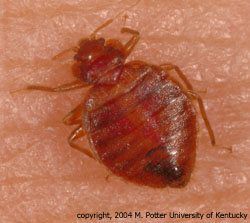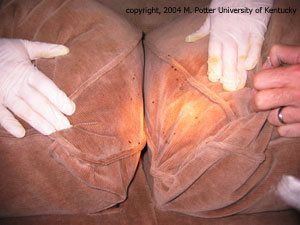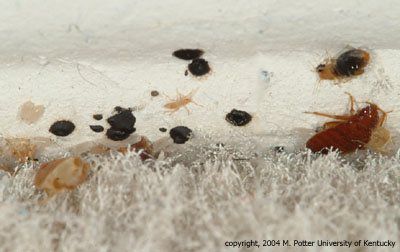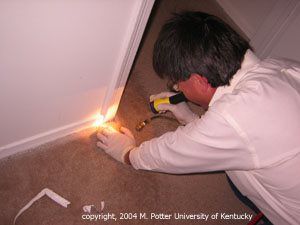Bed Bugs
When it comes to Bed Bugs we always defer to the best!
A TAC Exterminators uses Green Dog Pest Service K-9, canine-assisted bed bug detection teams, sometimes called bed bug dogs or bed bug sniffers.
To learn more about these nasty bugs please read this article below by Michael F. Potter, Extension Entomologist, University of Kentucky College of Agriculture. We could find no better information than this.
BED BUGS
by Michael F. Potter, Extension Entomologist University of Kentucky College of Agriculture
Most householders of this generation have never seen a bed bug. Until recently, they also were a rarity among pest control professionals. Bed bug infestations were common in the United States before World War II. But with improvements in hygiene, and especially the widespread use of DDT during the 1940s and ‘50s, the bugs all but vanished. The pests remained fairly prevalent, however, in other regions of the world including Asia, Africa, and Eastern Europe. In recent years, bed bugs have also made a comeback in the U.S. They are increasingly being encountered in homes, apartments, hotels, motels, health care facilities, dormitories, shelters, schools, and modes of transport. Other places where bed bugs sometimes appear include movie theaters, laundries/dry cleaners, furniture rental outlets and office buildings. Immigration and international travel have undoubtedly contributed to the resurgence of bed bugs in the U.S. Changes in modern pest control practice — and less effective bed bug pesticides — are other factors suspected for the recurrence.
Description and Habits
Bed bugs are small, brownish, flattened insects that feed solely on the blood of animals. The common bed bug, Cimex lectularius, is the species most adapted to living with humans. It has done so since ancient times. Bed bugs are mentioned in medieval European texts and in classical Greek writings back to the time of Aristotle. Other bed bug species prefer to feed on wild hosts, especially bats and birds.
Adult bed bugs are about 3/16-inch long and reddish-brown, with oval, flattened bodies. They are sometimes mistaken for ticks or cockroaches.
The immatures (nymphs) resemble the adults, but are smaller and lighter in color. Bed bugs do not fly, but can move rapidly over floors, walls, ceilings and other surfaces. Female bed bugs lay their eggs in secluded areas,depositing 1, 2 or more eggs per day and hundreds during a lifetime. The eggs are tiny, whitish, and hard to see on most surfaces without magnification (individual eggs are about the size of a dust speck). When first laid, the eggs are sticky, causing them to adhere to surfaces. Newly hatched nymphs are straw-colored and no bigger than a pinhead. As they grow, they molt (shed their skin) five times before reaching maturity. A blood meal is needed between each successive molt. Under favorable conditions (70-80°F), the bugs can complete development in as little as a month, producing three or more generations per year. Cooler temperatures or limited access to blood
extends the development time. Bed bugs are resilient.
Nymphs can survive months without feeding and the adults for more than a year. Infestations therefore are unlikely to diminish by leaving premises unoccupied. Although C. lectularius prefers feeding on humans, it will also bite other warm-blooded animals, including dogs, cats, birds and rodents.
Bed bugs are active mainly at night. During the daytime, they prefer to hide close to where people sleep. Their flattened bodies enable them to fit into tiny crevices — especially those associated with mattresses, box springs, bed frames and headboards. Bed bugs do not have nests like ants or bees, but do tend to congregate in habitual hiding places. Characteristically, these areas are marked by dark spotting and staining, which is the dried excrement of the bugs. Also present will be eggs and eggshells, the brownish molted skins of maturing nymphs and the bugs themselves. Another telltale though less frequent sign is rusty or reddish blood smears on bed sheets or mattresses from crushing an engorged bed bug. Heavy infestations may have a “buggy” smell, but the odor is seldom apparent and should not be relied upon for detection.
Bed bugs prefer to hide close to where they feed. However, if necessary, they will crawl several feet to obtain a blood meal. Initial infestations tend to be around beds, but the bugs eventually may become scattered throughout the bedroom, occupying any crevice or protected location. They also may spread to adjacent rooms or apartments.
Bites and Concerns
Content on this page requires a newer version of Adobe Flash Player.
Bed bugs usually bite people at night while they are sleeping. They feed by piercing the skin with an elongated beak through which they withdraw blood. Engorgement takes about three to 10 minutes, yet the person seldom knows they are being bitten. Bed bugs normally do not reside on people like head or body lice. Immediately after feeding they crawl off and reside elsewhere to digest their meal. Symptoms after being bitten vary with the individual. Many develop an itchy red welt or localized swelling within a day or so of the bite. Others have little or no reaction, and in some people the reaction is delayed. Unlike flea bites that occur mainly around the ankles, bed bugs feed on any skin exposed while sleeping (face, neck, shoulders, back, arms, legs, etc.). The welts and itching are often wrongly attributed to other causes, such as mosquitoes. For these reasons, infestations may go a long time unnoticed, and can become quite large before being detected. The likelihood of bed bugs increases if the affected individual has been traveling, or had acquired used beds or furnishings before symptoms started to appear. Bed bugs also are suspect if you wake up with itchy bites you did not have when you went to sleep. Conversely, it is important to recognize that not all bites or bite-like reactions are due to bed bugs. Confirmation requires finding and identifying the bugs themselves, which often requires the help of a professional. (Other possible sources of irritation are discussed in University of Kentucky entomology fact sheet ENT-58; Invisible Itches: Insect and Non-Insect Causes).
A common concern with bed bugs is whether they transmit diseases. Although bed bugs can harbor pathogens in and on their bodies, transmission to humans is considered unlikely. Their medical significance is chiefly limited to the itching and inflammation from their bites. Antihistamines and corticosteroids may be prescribed to reduce allergic reactions, and antiseptic or antibiotic ointments to prevent infection. Though not known to carry diseases, bed bugs can severely reduce quality of life by causing discomfort, sleeplessness, anxiety, and embarrassment.
Conventional insect repellents, like those used to deter ticks and mosquitoes, do not appear to be effective against bed bugs. Attempting to avoid being bitten by applying insect repellent at bedtime is not recommended. Sleeping with the lights on is not likely to deter hungry bed bugs either.
How Infestations Originate
It often seems that bed bugs arise from nowhere. The bugs are efficient hitchhikers and are usually transported in on luggage, clothing, beds, furniture, and other items. This is a particular problem for hotels, motels and apartments, where turnover of occupants is constant. Bed bugs are small, cryptic and agile, escaping detection after crawling into suitcases, boxes and belongings. The eggs are especially tiny and are usually overlooked. Acquiring secondhand beds, couches and furniture is another way that the bugs are transported into previously non-infested dwellings. Bed bugs also can be carried in on a person’s clothing or shoes, resulting in an infestation.
When bed bug-like insects are found, it’s important to consider whether bats, swallows, chimney swifts, pigeons or other wild hosts are involved. Although similar in appearance, species of bed bugs that normally feed on bats and birds can be differentiated from those that prefer humans. Entomologists and knowledgeable pest control firms can make this determination.
Controlling Infestations
Bed bugs are challenging pests to control. They hide in many tiny places, so inspections and treatments must be very thorough. In most cases, it will be prudent to enlist the services of a professional pest control firm. Experienced companies know where to look for bed bugs, and have an assortment of management tools at their disposal. Owners and occupants will need to assist the professional in important ways. Affording access for inspection and treatment is essential, and excess clutter should be removed. In some cases, infested mattresses and box springs will need to be discarded. Since bed bugs can disperse throughout a building, it also may be necessary to inspect adjoining rooms and apartments.
Where They Hide
Bed bugs can live in almost any crevice or protected location. The most common place to find them is the bed. Bed bugs often hide within seams, tufts and crevices of the mattress, box spring, bed frame and headboard.
Bed bugs often congregate along seams of mattresses and box springs. Blackish spots are excrement.
A thorough inspection requires dismantling the bed, and standing the components on edge so that upper and lower surfaces can be examined. Things to look for are the bugs themselves, and the light-brown, molted skins of the nymphs. Dark spots of dried bed bug excrement are often present along mattress seams or wherever the bugs have resided.
Box springs afford many places for bed bugs to hide, especially underneath where the fabric is stapled to the wooden frame. Oftentimes the underlying gauze dust cover must be removed to gain access for inspection and possible treatment. Successful treatment of mattresses and box springs is difficult, however, and infested ones may need to be
discarded or encased in a protective cover. Cracks and crevices of bed frames should be examined, especially if the frame is wood. (Bed bugs have an affinity for wood and fabric more so than metal or plastic). Headboards secured to walls should also be removed and inspected. In hotels and motels, the area behind the headboard is often the first place that the bugs become established. Bed bugs also hide among items stored under beds.
Bed bugs hidden beside a recessed screw under a nightstand.
During the early stages of a bed bug problem, the pests tend to congregate mostly in beds and other sleeping areas. As infestations grow larger, they tend to move beyond beds into other locations making control more difficult. Upholstered chairs and sofas should be examined above and beneath, especially seams, tufts, skirts and crevices. Sofas can be major bed bug hotspots, especially when used for sleeping. Like beds, they can be difficult to treat and may need to be discarded. Nightstands and dressers should be emptied and examined inside and out, then tipped over to inspect the woodwork underneath.
Oftentimes the bugs will be hiding in cracks, corners, and recesses. Other common places to find bed bugs include: along and under the edge of wall-to-wall carpeting (especially behind beds and furniture); cracks in wood molding; ceiling-wall junctures; behind wall-mounted picture frames, mirrors, switch plates and outlets; under loose wallpaper; amongst clothing and clutter stored in closets; and inside clocks, phones, televisions and smoke detectors.
Bed bugs often reside along baseboards. Photo shows eggs,
nymphs, and adults beneath carpet edge.
Bed bugs tend to congregate in certain areas, but it is common to find a single bug or some eggs scattered here and there. Persistence and a bright flashlight are requisites for success. A thorough inspection and treatment may take up to several hours. Some companies are beginning to use canines for detecting hard-to-find infestations. When properly trained, the dogs can be very effective. However at this time very few companies are using them due to the expense of training and maintaining such animals.
Controlling Infestations
Inspections and treatments must be very thorough
Bed bugs are challenging pests to control. Since they can hide in so many places, treatments must be thorough and elimination is not always a certainty. In most cases, it will be prudent to enlist the services of a professional. Experienced pest control firms know where to look for bed bugs, and have an assortment of management tools at their disposal.
Owners and occupants have an important role and will need to assist the professional. Affording access for inspection and treatment is crucial, and excess clutter will have to be removed. Belongings strewn about rooms afford many places for bed bugs to hide, and impedes inspection and treatment. Some pest control firms want furniture moved away from walls and mattresses and box springs stood on edge before
they arrive; others prefer to inspect first and move these items themselves. Since bed bugs can disperse throughout a building, it often will be necessary to inspect adjoining rooms and apartments.
Treatment Procedures.
Infested and infestation-prone bedding and garments will need to be bagged and laundered (120°F minimum) since these items cannot be treated with insecticides. Another effective and efficient option is to place clothing, toys, shoes, backpacks, etc., in a clothes dryer set at medium to high heat for 10 to 20 minutes. This will kill all bed bug life stages and can be done alone or in conjunction with laundering. According to textile experts at the Drycleaning & Laundry Institute (Laurel, MD), most garments designated as ‘dry-clean only’ (e.g., cotton, wool, silk, linen, rayon, nylon, poly blends) will not be harmed provided they are dry before being placed in a clothes dryer at moderate (less than 160?F) settings. While dry cleaning procedures also kill bed bugs, there is risk of infesting the establishment when buggy items are de-bagged, tagged and sorted.
Items which cannot be put in a washer or dryer can sometimes be de-infested by wrapping in plastic and placing them outdoors in a hot, sunny location, closed vehicle, etc. for at least a day. If this method is attempted, packing fewer items per bag makes it harder for the bugs to find cooler places to hide. Monitoring with a thermometer is prudent, with a target internal temperature of at least 120°F. Bed bugs also will succumb to cold temperatures below 32°F, but the freezing temperatures must be maintained for several days. Consequently, throughout much of the country, heating tends to be a faster, more reliable option than chilling. Attempts to rid an entire dwelling of bed bugs by raising or lowering the thermostat will be unsuccessful, although some companies are having success using supplemental heaters.
General housecleaning measures, such as vacuuming floors and surfaces, seldom reaches the places where bed bugs hide. Targeted vacuuming of infested harborages, however, can help remove some of the bugs before treatment with insecticides. Bed bugs and especially the eggs can be difficult to dislodge. Optimum results will be achieved by moving and scraping the end of the suction wand along infested areas such as seams and fabric folds of beds and sofas, and the perimeter edge of wall-to-wall carpets. Afterward, dispose of the vacuum contents in a sealed trash bag. Some pest control firms also employ commercial steamers or rapid freezing equipment to treat areas where bed bugs are found or suspected. Used correctly, they kill both bugs and eggs on contact. Neither method, however, affords residual protection against bed bugs which may have been missed.
At times it may be necessary to throw out infested items, especially beds and upholstered furniture. Knowledgeable pest control firms are able to advise clients on what can stay and what should go. When infested items are discarded, bagging or wrapping them prevents dislodgement of bugs en route to the Dumpster®.
While the aforementioned measures are helpful, insecticides are important for bed bug elimination. Professionals treat using a variety of low-odor sprays, dusts and aerosols. Baits designed to control ants and cockroaches are ineffective. Application entails treating all areas where the bugs are discovered or tend to crawl or hide. This may take hours of effort and follow-up visits are usually required.
Some bed bug species are parasites of bats or birds, and may bite people if the wild hosts are no longer available. If bat bugs or bird bugs are involved, roosting and nesting sites should be the primary focus of treatment and the animals excluded from the building.
Do I Have to Throw Out the Bed?
Eliminating bed bugs from beds can be challenging. If there are holes or tears in the fabric, the bugs and eggs may be inside, as well as outside. There also are restrictions on how beds can be treated with pesticides. For these reasons, companies sometimes recommend that beds be discarded, especially when heavily infested or in poor condition. Another option is to encase both the mattress and box spring in a protective cover like those used for allergy relief. Encasements specifically designed to help protect against bed bugs are available through retail outlets or pest control firms. Once the cover is installed and zipped shut, any bugs which happen to be inside are entombed and eventually will die. Encasements also help protect newly purchased beds, and make it easier to spot and destroy any bugs residing on the outer surface during subsequent examination. Encasements will not, however, keep bed bugs from crawling onto a bed and biting a sleeping person.
Bed bugs are frequently found on the undersides of box springs.
Some companies treat seams, tufts, and crevices of bed components with insecticides, but they usually will not spray the entire mattress surface. They also should not spray bed sheets, blankets or clothing, which should be laundered. Vacuuming and steaming further help to eliminate bugs and eggs from beds, but afford no residual protection and may not kill bed bugs hidden inside the box spring or mattress. Fumigation is another way to de-infest beds and hard-to-treat items, but the procedure is not always available. In extreme cases, entire buildings have been fumigated for bed bugs. The service can be quite costly though, and involves covering the building in a tarp and injecting a lethal gas. Some companies also de-infest such items with specialized heating equipment.
Preventing Infestations:
As difficult as it can be to eradicate bed bugs, it makes great sense to take precautions to avoid them in the first place. Householders should be vigilant when acquiring used furnishings, especially beds and couches. Curbside items should be avoided, and secondhand articles should be examined closely before being brought into the home, and perhaps laundered or placed in a dryer. Avoiding problems with bed bugs is most challenging in apartments, hotels and other places where there are ongoing opportunities for the bugs to be introduced. Preventative inspection by tenants, housekeeping staff, or pest control firms is the best way to uncover infestations in their initial stages when they are easiest to control.
Discarded beds and couches might be infested and should be left alone.
Concerned travelers may want to get in the habit of checking their bed for signs of bed bugs, a common practice in the past. This would entail examining the bed sheets and upper and lower seams of the mattress and box spring, especially along the head of the bed. Some professionals also suggest removal and examination behind the headboard, a frequent hiding place for the bugs in hotel rooms. Headboards are heavy and cumbersome, however, and untrained persons should not attempt removal themselves. If bed bugs are discovered,
travelers can request another room, preferably in another area of the building. Vigilant travelers may also want to elevate suitcases off the floor on a luggage stand, tabletop or other hard surface. Should travelers experience itchy welts suggestive of bed bug bites during their stay, it would be prudent upon returning home (before unpacking) to place all clothing in disposable plastic bags and directly into the washer and/or dryer. Inspecting or vacuuming luggage upon arrival home is less useful since it’s hard to spot bed bugs inside a suitcase. The suitcase itself can either be treated or discarded
The incidence of bed bugs in the United States is increasing to the point where vigilance by all is a prudent practice. Familiarity can help to avoid infestation, or at least prompt earlier intervention by a professional.













